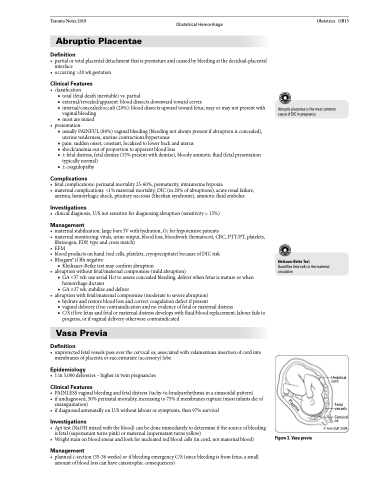Page 855 - TNFlipTest
P. 855
Toronto Notes 2019 Obstetrical Hemorrhage Abruptio Placentae
Definition
• partialortotalplacentaldetachmentthatisprematureandcausedbybleedingatthedecidual-placental interface
• occurring>20wkgestation
Clinical Features
• classification
■ total (fetal death inevitable) vs. partial
■ external/revealed/apparent: blood dissects downward toward cervix
■ internal/concealed/occult (20%): blood dissects upward toward fetus, may or may not present with
vaginal bleeding ■ most are mixed
• presentation
■ usually PAINFUL (80%) vaginal bleeding (bleeding not always present if abruption is concealed),
uterine tenderness, uterine contractions/hypertonus
■ pain: sudden onset, constant, localized to lower back and uterus
■ shock/anemia out of proportion to apparent blood loss
■ ± fetal distress, fetal demise (15% present with demise), bloody amniotic fluid (fetal presentation
typically normal)
■ ±coagulopathy
Complications
• fetalcomplications:perinatalmortality25-60%,prematurity,intrauterinehypoxia
• maternalcomplications:<1%maternalmortality,DIC(in20%ofabruptions),acuterenalfailure,
anemia, hemorrhagic shock, pituitary necrosis (Sheehan syndrome), amniotic fluid embolus
Investigations
• clinicaldiagnosis,U/Snotsensitivefordiagnosingabruption(sensitivity=15%)
Management
• maternal stabilization: large bore IV with hydration, O2 for hypotensive patients
• maternalmonitoring:vitals,urineoutput,bloodloss,bloodwork(hematocrit,CBC,PTT/PT,platelets,
fibrinogen, FDP, type and cross match)
• EFM
• bloodproductsonhand(redcells,platelets,cryoprecipitate)becauseofDICrisk
• Rhogam®ifRhnegative
■ Kleihauer-Betke test may confirm abruption
• abruption without fetal/maternal compromise (mild abruption)
■ GA <37 wk: use serial Hct to assess concealed bleeding, deliver when fetus is mature or when hemorrhage dictates
■ GA ≥37 wk: stabilize and deliver
• abruptionwithfetal/maternalcompromise(moderatetosevereabruption)
■ hydrate and restore blood loss and correct coagulation defect if present
■ vaginal delivery if no contraindication and no evidence of fetal or maternal distress
■ C/S if live fetus and fetal or maternal distress develops with fluid/blood replacement, labour fails to
progress, or if vaginal delivery otherwise contraindicated
Vasa Previa
Definition
• unprotectedfetalvesselspassoverthecervicalos;associatedwithvelamentousinsertionofcordinto membranes of placenta or succenturiate (accessory) lobe
Epidemiology
• 1in5,000deliveries–higherintwinpregnancies
Clinical Features
• PAINLESSvaginalbleedingandfetaldistress(tachy-to-bradyarrhythmiainasinusoidalpattern)
• ifundiagnosed,50%perinatalmortality,increasingto75%ifmembranesrupture(mostinfantsdieof
exsanguination)
• ifdiagnosedantenatallyonU/Swithoutlabourorsymptoms,then97%survival
Investigations
• Apt test (NaOH mixed with the blood) can be done immediately to determine if the source of bleeding is fetal (supernatant turns pink) or maternal (supernatant turns yellow)
• Wrightstainonbloodsmearandlookfornucleatedredbloodcells(incord,notmaternalblood)
Management
• plannedc-section(35-36weeks)orifbleedingemergencyC/S(sincebleedingisfromfetus,asmall amount of blood loss can have catastrophic consequences)
Obstetrics OB15
Abruptio placentae is the most common cause of DIC in pregnancy
Kleihauer-Betke Test
Quantifies fetal cells in the maternal circulation
Umbilical cord
Fetal vessels
Cervical os
© Erin Duff 2009
Figure 3. Vasa previa
Placenta


